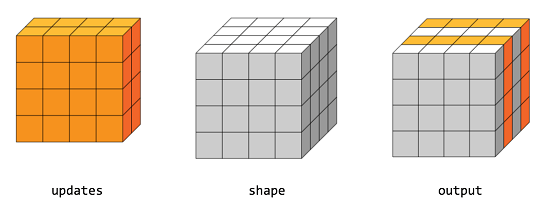
TensorFlow函数:tf.scatter_nd
tf.scatter_nd 函数
scatter_nd(
indices,
updates,
shape,
name=None
)参见指南:张量变换>分割和连接
根据indices将updates散布到新的(初始为零)张量.
根据索引对给定shape的零张量中的单个值或切片应用稀疏updates来创建新的张量.此运算符是tf.gather_nd运算符的反函数,它从给定的张量中提取值或切片.
警告:更新应用的顺序是非确定性的,所以如果indices包含重复项的话,则输出将是不确定的.
indices是一个整数张量,其中含有索引形成一个新的形状shape张量.indices的最后的维度可以是shape的最多的秩:
indices.shape[-1] <= shape.rankindices的最后一个维度对应于沿着shape的indices.shape[-1]维度的元素的索引(if indices.shape[-1] = shape.rank)或切片(if indices.shape[-1] < shape.rank)的索引.updates是一个具有如下形状的张量:
indices.shape[:-1] + shape[indices.shape[-1]:]最简单的分散形式是通过索引将单个元素插入到张量中.例如,假设我们想要在8个元素的1级张量中插入4个分散的元素.

在Python中,这个分散操作看起来像这样:
indices = tf.constant([[4], [3], [1], [7]])
updates = tf.constant([9, 10, 11, 12])
shape = tf.constant([8])
scatter = tf.scatter_nd(indices, updates, shape)
with tf.Session() as sess:
print(sess.run(scatter))由此产生的张量将如下所示:
[0, 11, 0, 10, 9, 0, 0, 12]我们也可以一次插入一个更高阶张量的整个片.例如,如果我们想要在具有两个新值的矩阵的第三维张量中插入两个切片.

在Python中,这个分散操作看起来像这样:
indices = tf.constant([[0], [2]])
updates = tf.constant([[[5, 5, 5, 5], [6, 6, 6, 6],
[7, 7, 7, 7], [8, 8, 8, 8]],
[[5, 5, 5, 5], [6, 6, 6, 6],
[7, 7, 7, 7], [8, 8, 8, 8]]])
shape = tf.constant([4, 4, 4])
scatter = tf.scatter_nd(indices, updates, shape)
with tf.Session() as sess:
print(sess.run(scatter))由此产生的张量将如下所示:
[[[5, 5, 5, 5], [6, 6, 6, 6], [7, 7, 7, 7], [8, 8, 8, 8]],
[[0, 0, 0, 0], [0, 0, 0, 0], [0, 0, 0, 0], [0, 0, 0, 0]],
[[5, 5, 5, 5], [6, 6, 6, 6], [7, 7, 7, 7], [8, 8, 8, 8]],
[[0, 0, 0, 0], [0, 0, 0, 0], [0, 0, 0, 0], [0, 0, 0, 0]]]函数参数
- indices:一个Tensor;必须是以下类型之一:int32,int64;指数张量.
- updates:一个Tensor;分散到输出的更新.
- shape:一个Tensor;必须与indices具有相同的类型;1-d;得到的张量的形状.
- name:操作的名称(可选).
函数返回值
此函数将返回一个Tensor,它与updates有相同的类型;根据indices应用的一个新具有给定的形状和更新的张量.